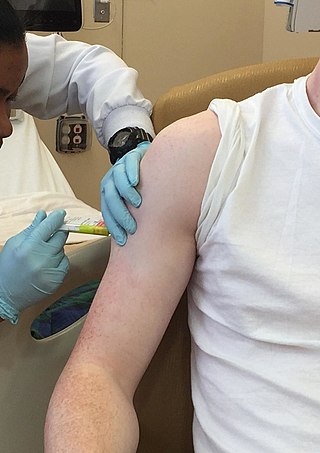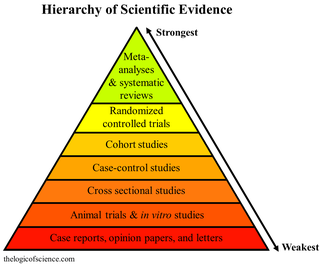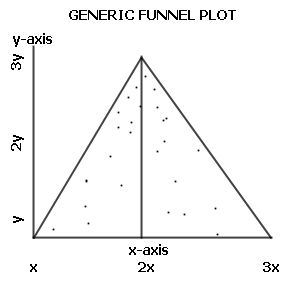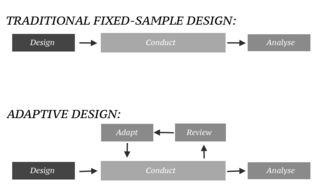Related Research Articles
Evidence-based medicine (EBM) is "the conscientious, explicit and judicious use of current best evidence in making decisions about the care of individual patients." The aim of EBM is to integrate the experience of the clinician, the values of the patient, and the best available scientific information to guide decision-making about clinical management. The term was originally used to describe an approach to teaching the practice of medicine and improving decisions by individual physicians about individual patients.

A randomized controlled trial is a form of scientific experiment used to control factors not under direct experimental control. Examples of RCTs are clinical trials that compare the effects of drugs, surgical techniques, medical devices, diagnostic procedures, diets or other medical treatments.

Clinical trials are prospective biomedical or behavioral research studies on human participants designed to answer specific questions about biomedical or behavioral interventions, including new treatments and known interventions that warrant further study and comparison. Clinical trials generate data on dosage, safety and efficacy. They are conducted only after they have received health authority/ethics committee approval in the country where approval of the therapy is sought. These authorities are responsible for vetting the risk/benefit ratio of the trial—their approval does not mean the therapy is 'safe' or effective, only that the trial may be conducted.
In a blind or blinded experiment, information which may influence the participants of the experiment is withheld until after the experiment is complete. Good blinding can reduce or eliminate experimental biases that arise from a participants' expectations, observer's effect on the participants, observer bias, confirmation bias, and other sources. A blind can be imposed on any participant of an experiment, including subjects, researchers, technicians, data analysts, and evaluators. In some cases, while blinding would be useful, it is impossible or unethical. For example, it is not possible to blind a patient to their treatment in a physical therapy intervention. A good clinical protocol ensures that blinding is as effective as possible within ethical and practical constraints.
In published academic research, publication bias occurs when the outcome of an experiment or research study biases the decision to publish or otherwise distribute it. Publishing only results that show a significant finding disturbs the balance of findings in favor of positive results. The study of publication bias is an important topic in metascience.
Sir Richard Peto is an English statistician and epidemiologist who is Professor of Medical Statistics and Epidemiology at the University of Oxford, England.

A systematic review is a scholarly synthesis of the evidence on a clearly presented topic using critical methods to identify, define and assess research on the topic. A systematic review extracts and interprets data from published studies on the topic, then analyzes, describes, critically appraises and summarizes interpretations into a refined evidence-based conclusion. For example, a systematic review of randomized controlled trials is a way of summarizing and implementing evidence-based medicine.
The Bristol stool scale is a diagnostic medical tool designed to classify the form of human faeces into seven categories. It is used in both clinical and experimental fields.
In medicine an intention-to-treat (ITT) analysis of the results of a randomized controlled trial is based on the initial treatment assignment and not on the treatment eventually received. ITT analysis is intended to avoid various misleading artifacts that can arise in intervention research such as non-random attrition of participants from the study or crossover. ITT is also simpler than other forms of study design and analysis, because it does not require observation of compliance status for units assigned to different treatments or incorporation of compliance into the analysis. Although ITT analysis is widely employed in published clinical trials, it can be incorrectly described and there are some issues with its application. Furthermore, there is no consensus on how to carry out an ITT analysis in the presence of missing outcome data.
In a randomized experiment, allocation concealment hides the sorting of trial participants into treatment groups so that this knowledge cannot be exploited. Adequate allocation concealment serves to prevent study participants from influencing treatment allocations for subjects. Studies with poor allocation concealment are prone to selection bias.

In science, randomized experiments are the experiments that allow the greatest reliability and validity of statistical estimates of treatment effects. Randomization-based inference is especially important in experimental design and in survey sampling.

A funnel plot is a graph designed to check for the existence of publication bias; funnel plots are commonly used in systematic reviews and meta-analyses. In the absence of publication bias, it assumes that studies with high precision will be plotted near the average, and studies with low precision will be spread evenly on both sides of the average, creating a roughly funnel-shaped distribution. Deviation from this shape can indicate publication bias.
The Jadad scale, sometimes known as Jadad scoring or the Oxford quality scoring system, is a procedure to assess the methodological quality of a clinical trial by objective criteria. It is named after Canadian-Colombian physician Alex Jadad who in 1996 described a system for allocating such trials a score of between zero and five (rigorous). It is the most widely used such assessment in the world, and as of 2022, its seminal paper has been cited in over 23,000 scientific works.
A cluster-randomised controlled trial is a type of randomised controlled trial in which groups of subjects are randomised. Cluster randomised controlled trials are also known as cluster-randomised trials, group-randomised trials, and place-randomized trials. Cluster-randomised controlled trials are used when there is a strong reason for randomising treatment and control groups over randomising participants.
SABRE Research UK was a British charity raising awareness of the need to remove bias from the conduct and scientific evaluation of animal research. It addressed issues in systematic reviews of animal studies. The charity was previously known as the Society for Accountability of Animal Studies in Biomedical Research and Education and was constituted in 2005 in response to disquiet about uninformed opinions about the scientific value of animal studies and dissatisfaction with polarised positions in the debate about animal research. The charity reported that neither the proponents of animal research nor its opponents were able to produce sufficiently sound scientific evidence in support of their opposing cases.
George Lewith was a professor at the University of Southampton researching alternative medicine and a practitioner of complementary medicine. He was a prominent and sometimes controversial advocate of complementary medicine in the UK.
A significant amount of research has been performed on glycosaminoglycans, especially glucosamine and chondroitin, for the treatment of arthritis. These compounds are commonly marketed as nutritional supplements and numerous 'soft therapeutic claims' are made about their health benefits - especially in aging populations. Since glucosamine is a precursor for glycosaminoglycans, and glycosaminoglycans are major components of cartilage, ingesting glucosamine might nourish joints, and thereby alleviate arthritis symptoms. Authoritative opinions on the actual therapeutic value of these compounds have been very mixed.
In medicine, a stepped-wedge trial is a type of randomised controlled trial (RCT). An RCT is a scientific experiment that is designed to reduce bias when testing a new medical treatment, a social intervention, or another testable hypothesis.
Individual participant data is raw data from individual participants, and is often used in the context of meta-analysis.

In an adaptive design of a clinical trial, the parameters and conduct of the trial for a candidate drug or vaccine may be changed based on an interim analysis. Adaptive design typically involves advanced statistics to interpret a clinical trial endpoint. This is in contrast to traditional single-arm clinical trials or randomized clinical trials (RCTs) that are static in their protocol and do not modify any parameters until the trial is completed. The adaptation process takes place at certain points in the trial, prescribed in the trial protocol. Importantly, this trial protocol is set before the trial begins with the adaptation schedule and processes specified. Adaptions may include modifications to: dosage, sample size, drug undergoing trial, patient selection criteria and/or "cocktail" mix. The PANDA provides not only a summary of different adaptive designs, but also comprehensive information on adaptive design planning, conduct, analysis and reporting.
References
- 1 2 3 4 5 6 7 Thabane L, Ma J, Chu R, Cheng J, Ismaila A, Rios LP, et al. (January 2010). "A tutorial on pilot studies: the what, why and how". BMC Medical Research Methodology. 10 (1): 1. doi: 10.1186/1471-2288-10-1 . PMC 2824145 . PMID 20053272.
- 1 2 3 4 Lewis M, Bromley K, Sutton CJ, McCray G, Myers HL, Lancaster GA (February 2021). "Determining sample size for progression criteria for pragmatic pilot RCTs: the hypothesis test strikes back!". Pilot and Feasibility Studies. 7 (1): 40. doi: 10.1186/s40814-021-00770-x . PMC 7856754 . PMID 33536076.
- ↑ Billé R, Duchemin B (February 2010). "Action without change? On the use and usefulness of pilot experiments in environmental management". SAPIEN. Surveys and Perspectives Integrating Environment and Society. 4 (1).
- ↑ Leon AC, Davis LL, Kraemer HC (May 2011). "The role and interpretation of pilot studies in clinical research". Journal of Psychiatric Research. 45 (5): 626–629. doi:10.1016/j.jpsychires.2010.10.008. PMC 3081994 . PMID 21035130.
- ↑ Eldridge SM, Lancaster GA, Campbell MJ, Thabane L, Hopewell S, Coleman CL, Bond CM (2016). "Defining Feasibility and Pilot Studies in Preparation for Randomised Controlled Trials: Development of a Conceptual Framework". PLOS ONE. 11 (3): e0150205. Bibcode:2016PLoSO..1150205E. doi: 10.1371/journal.pone.0150205 . PMC 4792418 . PMID 26978655.
- ↑ "The drug development process: Step 3: Clinical research". US Food and Drug Administration. 4 January 2018. Retrieved 29 March 2021.
- ↑ Sim J (December 2019). "Should treatment effects be estimated in pilot and feasibility studies?". Pilot and Feasibility Studies. 5 (1): 107. doi: 10.1186/s40814-019-0493-7 . PMC 6712606 . PMID 31485336.
- ↑ Eldridge SM, Chan CL, Campbell MJ, Bond CM, Hopewell S, Thabane L, Lancaster GA, et al. (PAFS Consensus Group) (October 2016). "CONSORT 2010 statement: extension to randomised pilot and feasibility trials". BMJ. 355: i5239. doi:10.1136/bmj.i5239. PMC 5076380 . PMID 27777223.